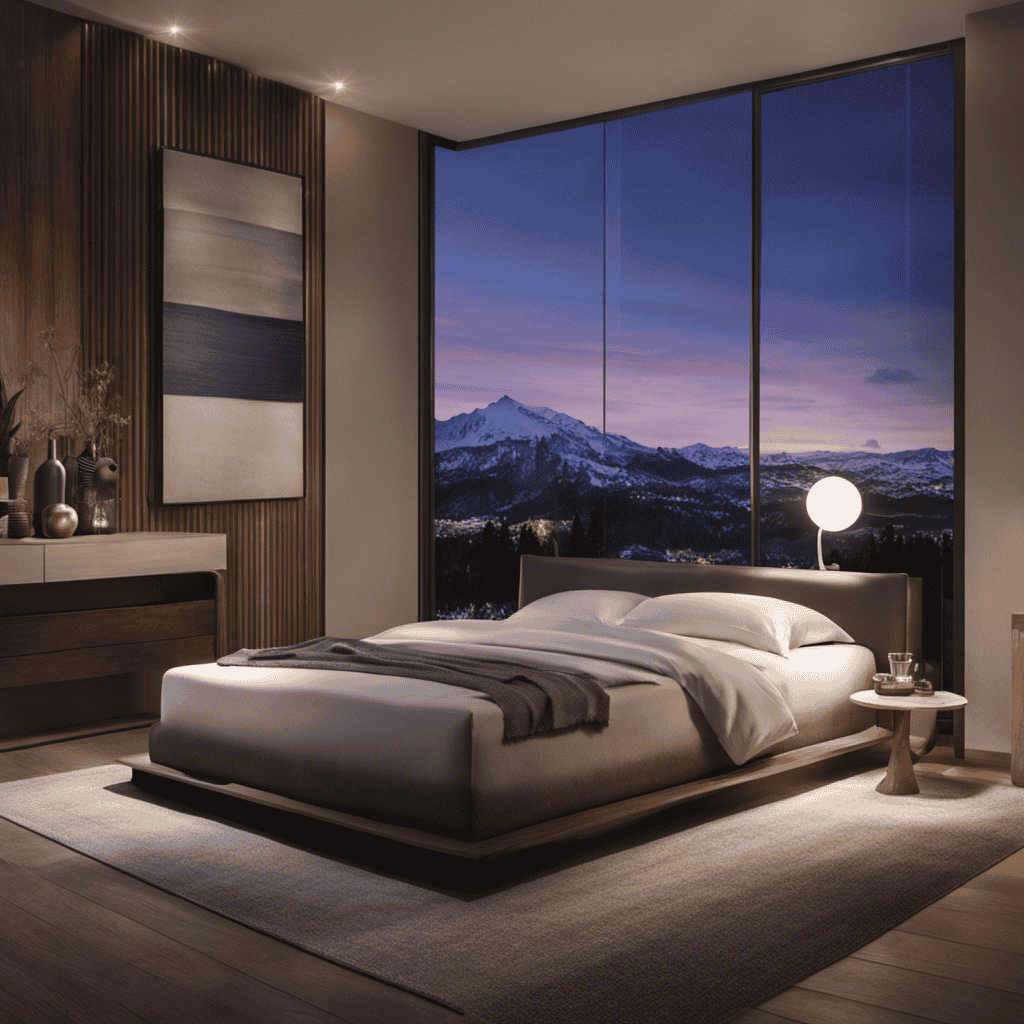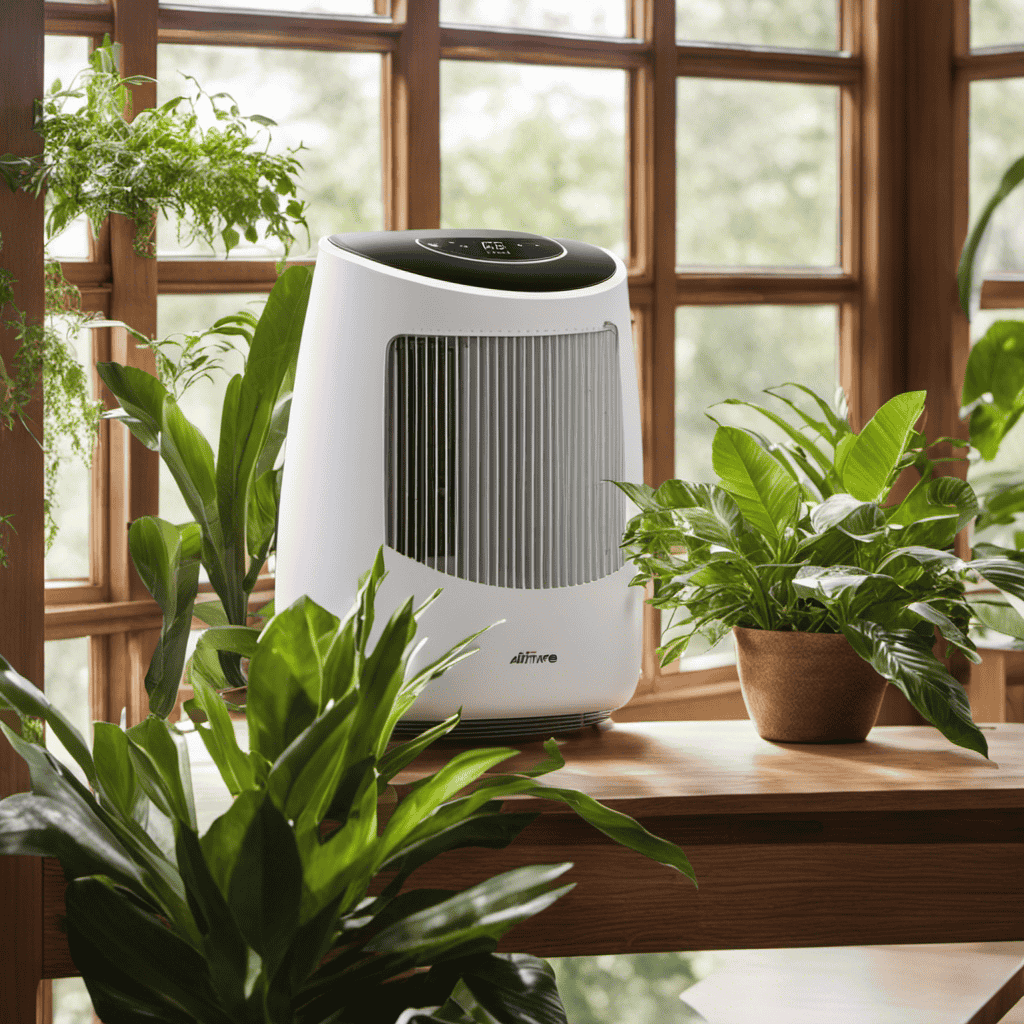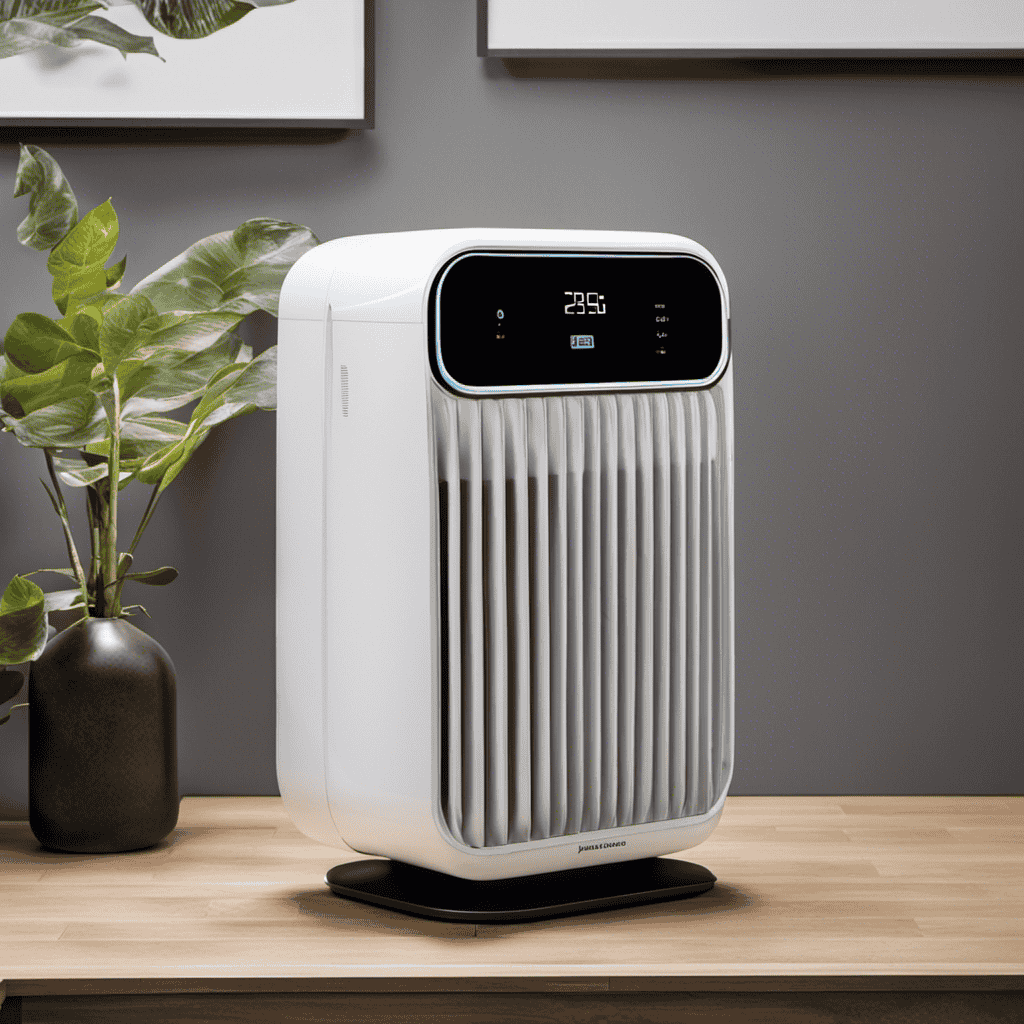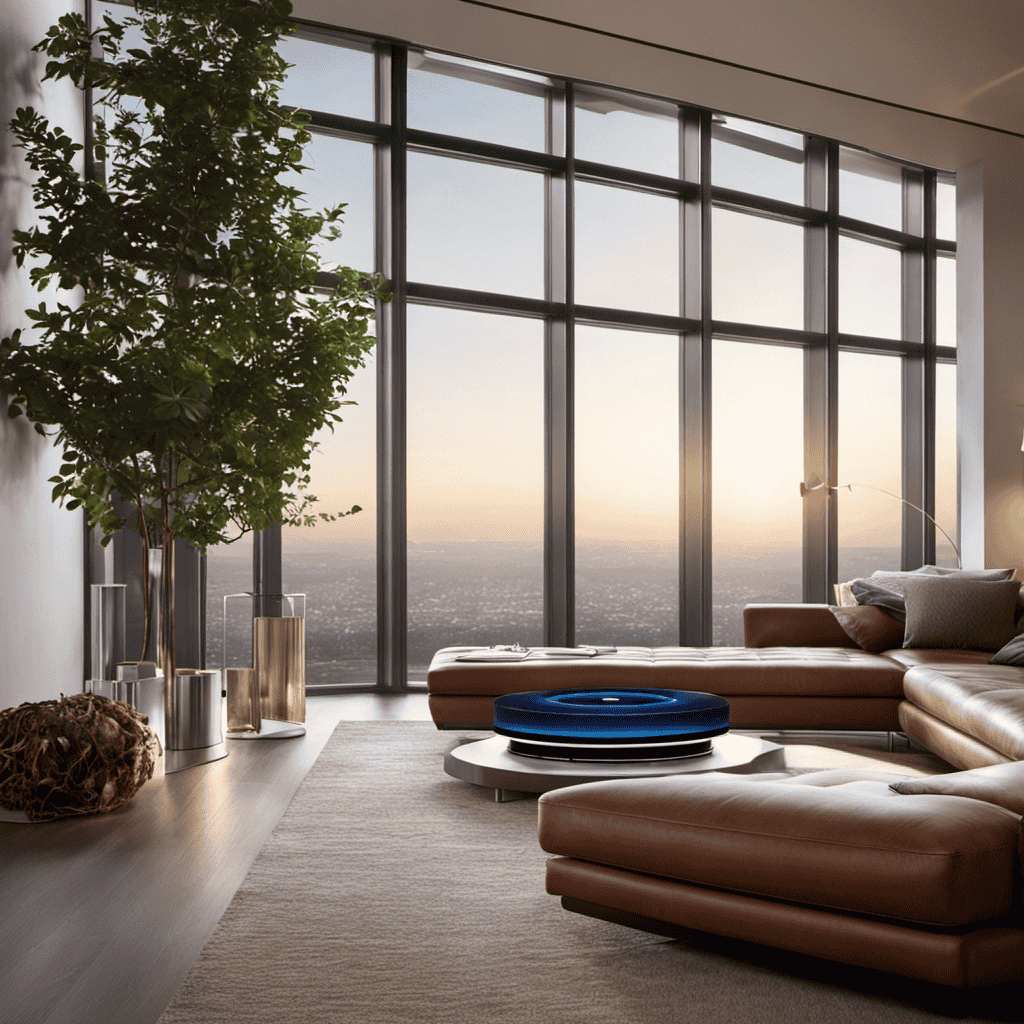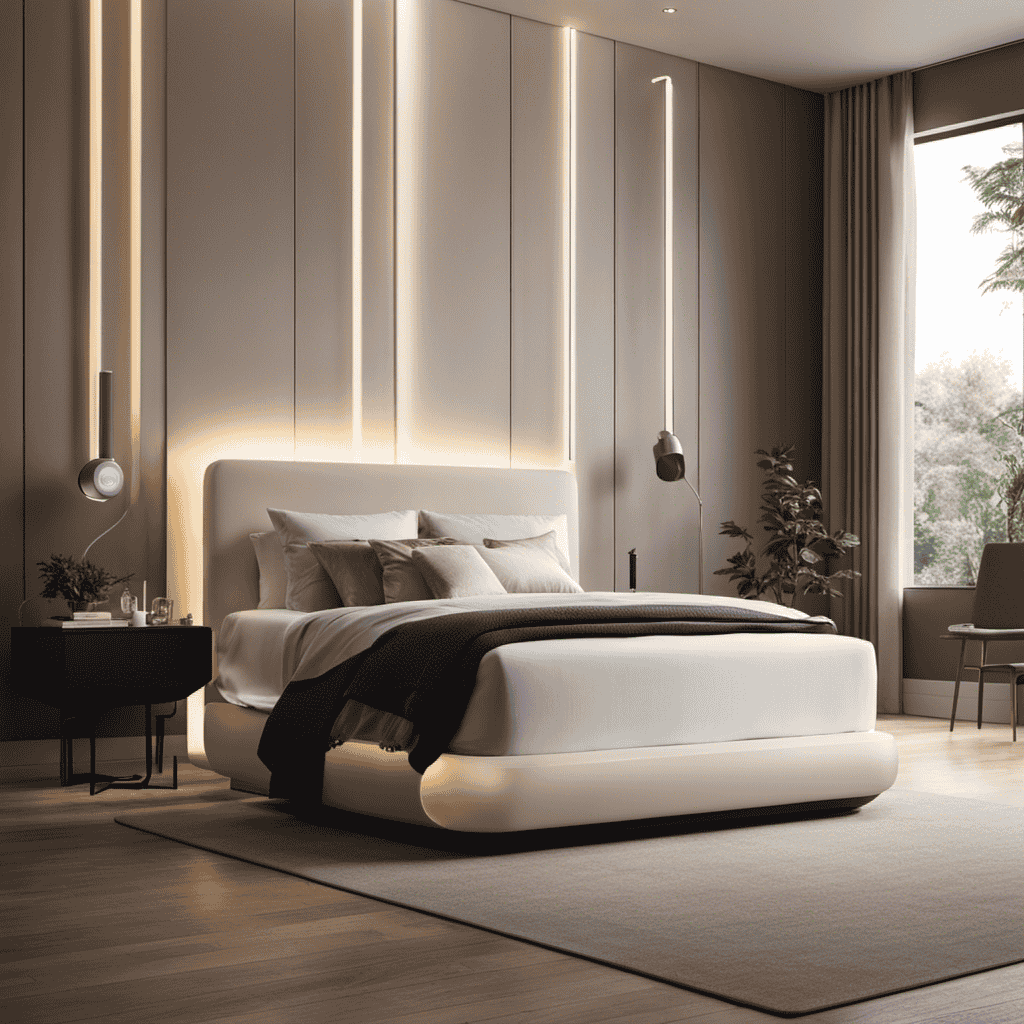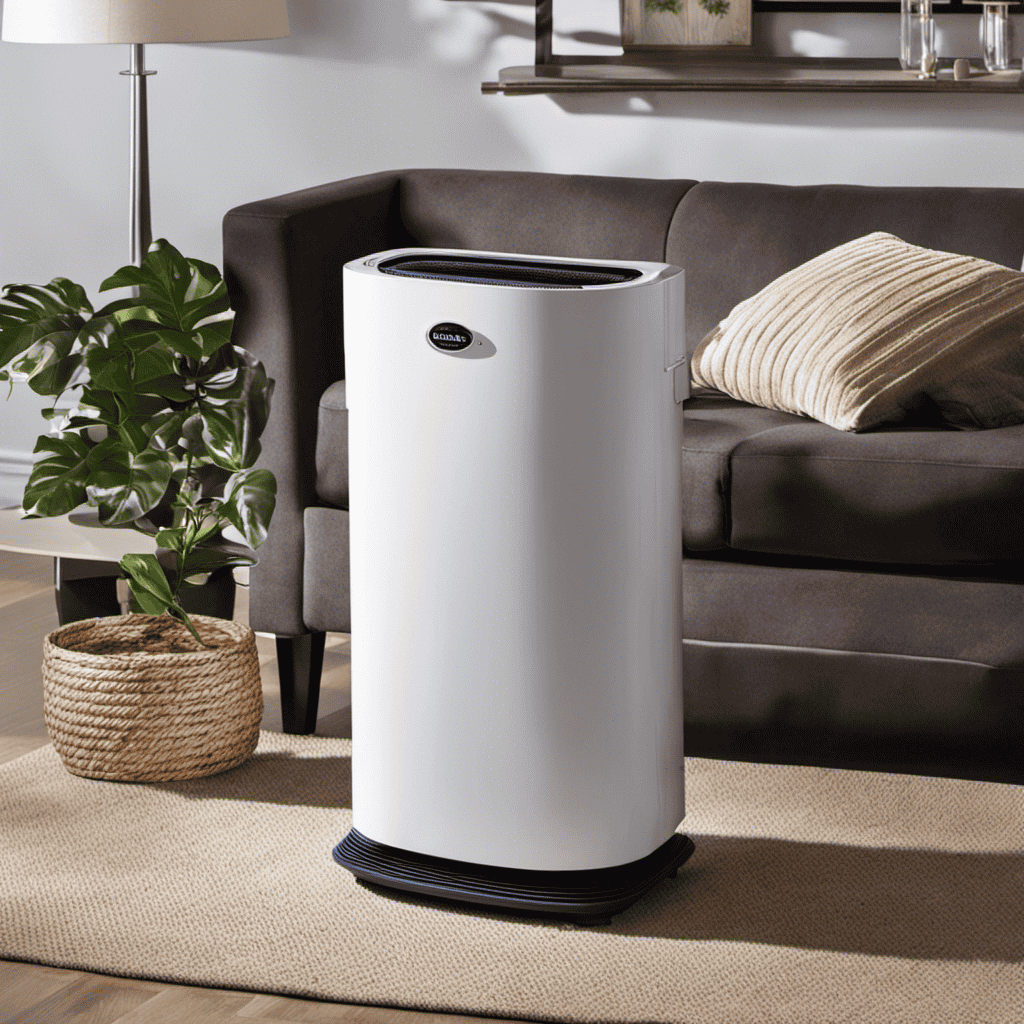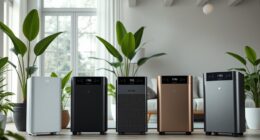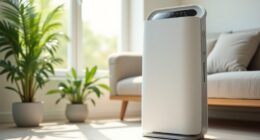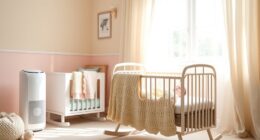I never imagined I’d be so worried about the quality of the air I inhale, yet the deeper my understanding grew, the clearer it became how crucial it is to operate an air purifier.
With all the pollutants and allergens floating around, it’s essential to take steps to improve the quality of the air in our homes.
In this article, we’ll explore the benefits of running an air purifier, factors to consider before starting, and the ideal times and durations for maximum effectiveness.
Get ready to breathe easier and discover when you should run your air purifier.
Key Takeaways
- Conduct an air quality assessment before running an air purifier.
- Consider the size of the room and the level of pollutants when determining the optimal usage frequency.
- Regular maintenance and filter replacement are necessary for optimal performance.
- Air purifiers can provide relief for allergies and asthma, as well as reduce odors from cooking or pets.
Benefits of Running an Air Purifier
You’ll love the benefits of running an air purifier in your home. Not only does it help to improve the air quality, but it also provides numerous health benefits.
One of the main advantages of using an air purifier is that it helps to remove airborne pollutants such as dust, pollen, pet dander, and mold spores. This can be particularly beneficial for individuals who suffer from allergies or asthma.
In addition to improving air quality, running an air purifier can also help to reduce odors, such as those from cooking or pets.
To ensure optimal performance, regular air purifier maintenance is necessary. This includes cleaning or replacing filters as recommended by the manufacturer.
When it comes to air purifier placement, it is important to position it in a central area of your home where it can effectively circulate and clean the air.
Factors to Consider Before Running an Air Purifier
Before deciding to use an air purifier, it’s important to consider various factors. Here are four factors to consider before running an air purifier:
-
Air quality assessment: Conduct a thorough assessment of your indoor air quality to determine if an air purifier is necessary. Factors such as pollen, pet dander, dust mites, and mold spores can significantly impact air quality.
-
Room size: Consider the size of the room where you plan to use the air purifier. Different air purifiers have different coverage areas, so it’s important to choose one that can effectively clean the air in your specific space.
-
Noise level: Some air purifiers can generate noise, especially when running at higher speeds. If you are sensitive to noise or plan to use the air purifier in a bedroom or office, consider models with lower noise levels.
-
Maintenance and filter replacement: Regular maintenance and filter replacement are essential for the optimal performance of an air purifier. Consider the cost and availability of replacement filters before making a purchase.
Considering these factors will help ensure that you choose the right air purifier for your needs and maximize its effectiveness in improving indoor air quality.
Transition: Now that we have considered the factors to consider before running an air purifier, let’s explore how often you should run your air purifier to maintain clean and healthy air.
How Often Should You Run Your Air Purifier
When it comes to running an air purifier, determining the optimal usage frequency is crucial in maintaining clean and healthy air in your environment. Understanding the health benefits associated with running an air purifier can help you make informed decisions about when and how often to use it.
Additionally, there are several factors that can influence the usage of an air purifier, such as the size of the room, the presence of specific pollutants, and the overall air quality in your area.
Optimal Usage Frequency
To get the most out of your air purifier, it’s important to know how often to use it. Here are some guidelines to help you determine the ideal running duration for your air purifier:
Consider the air quality: If you live in an area with poor air quality or have respiratory issues, running the air purifier continuously may be beneficial.
Assess the size of the room: For smaller rooms, running the air purifier for a few hours a day should suffice. However, larger rooms may require longer running durations.
Evaluate the level of pollutants: If you have pets or live in a highly polluted area, running the air purifier for longer periods can help maintain clean air.
Monitor your electricity bill: Running the air purifier 24/7 can significantly impact your electricity bill. Consider running it on a schedule or using energy-saving modes to reduce costs.
Health Benefits Explained
Running an air purifier continuously can be beneficial for individuals living in areas with poor air quality or those who have respiratory issues. Research has shown that air purifiers effectively reduce the presence of airborne pollutants such as dust, pollen, pet dander, and mold spores, which can trigger allergies and asthma. However, it is important to note that proper maintenance is crucial to ensure optimal performance. Regularly cleaning and replacing filters, as well as cleaning the unit itself, can prevent the accumulation of particles and maintain its efficiency. Additionally, noise levels should be taken into consideration. Many air purifiers now feature noise-reducing technologies, allowing for quiet operation, especially during sleep. Considering these factors, it is clear that running an air purifier continuously can significantly improve indoor air quality and promote better respiratory health.
Moving on to factors influencing usage…
Factors Influencing Usage
In my research on the factors influencing the usage of air purifiers, I have found that two significant factors are the influence of humidity and the impact of pets. Here are some key points to consider:
-
Humidity: High humidity levels can create a breeding ground for mold and mildew, which can worsen indoor air quality. Air purifiers with dehumidifying capabilities can help reduce moisture in the air and prevent the growth of these allergens.
-
Pets: Our furry friends bring joy to our lives, but they can also introduce pet dander and fur into our homes. Air purifiers equipped with HEPA filters can capture these particles, reducing pet-related allergies and improving overall indoor air quality.
-
Allergies and Asthma: Both humidity and pet allergens can trigger allergies and asthma symptoms. By reducing these triggers, air purifiers can provide relief and improve respiratory health.
-
Odor Control: Pets can also bring unwanted odors into our homes. Air purifiers with activated carbon filters can effectively remove pet odors, leaving our living spaces fresh and clean.
Considering these factors, it is important to run air purifiers in environments with high humidity levels or when living with pets to maintain optimal indoor air quality.
Signs That Indicate the Need to Run an Air Purifier
If you’re experiencing frequent allergy symptoms like sneezing and coughing, it may be time to run your air purifier. But when should you actually do it?
First, consider the ideal locations for your air purifier. Place it in the room where you spend the most time, like your bedroom or living room. These areas tend to accumulate more dust, pet dander, and pollen.
Additionally, make sure to maintain your air purifier properly. Regularly clean or replace the filters to ensure optimal performance. Some models even have indicators that let you know when it’s time for maintenance. Remember to vacuum the area around the air purifier to prevent dust buildup.
Ideal Times to Run Your Air Purifier
When it comes to optimizing the use of air purifiers, there are several key points to consider.
First, using an air purifier during sleeping time can greatly improve the quality of sleep by reducing allergens and pollutants in the air.
Second, for individuals with allergies, running an air purifier throughout the day can provide relief by filtering out common allergens such as dust mites, pollen, and pet dander.
Finally, using an air purifier while cooking can help eliminate cooking odors and reduce the presence of harmful indoor pollutants such as volatile organic compounds (VOCs) released during the cooking process.
Considering these factors can help maximize the effectiveness of air purifiers in creating a clean and healthy indoor environment.
Sleeping Time and Air Purifiers
During your sleeping time, it’s important to ensure that the air purifier is running. Here’s why:
-
Allergies prevention: Many people suffer from allergies that can disrupt their sleep. Air purifiers can help remove allergens such as dust mites, pollen, and pet dander from the air, reducing the likelihood of allergic reactions.
-
Air quality improvement: Indoor air can be more polluted than outdoor air, and poor air quality can affect the quality of your sleep. Air purifiers can help remove pollutants like smoke, odors, and volatile organic compounds (VOCs), creating a cleaner and healthier environment for sleep.
-
Respiratory health benefits: Breathing clean air while you sleep can improve respiratory health, especially for individuals with asthma or other respiratory conditions. Air purifiers can filter out particles that can irritate the airways, promoting better breathing during sleep.
-
Peaceful sleep: The white noise produced by some air purifiers can help mask external sounds, creating a more peaceful and conducive sleep environment.
By running an air purifier during your sleeping time, you can enhance your sleep quality and wake up feeling refreshed and rejuvenated.
Now, let’s explore the relationship between allergies and air purifiers.
Allergies and Air Purifiers
To alleviate your allergies, consider using an air purifier as it helps remove allergens from the air.
Air purifiers can be particularly beneficial for individuals who have pets, as they can help to reduce the amount of pet dander in the air. Pet dander is a common allergen that can trigger respiratory symptoms in sensitive individuals.
By filtering out pet dander, air purifiers can help improve overall indoor air quality and reduce the risk of allergic reactions.
In addition to addressing pet allergens, air purifiers can also have positive effects on respiratory health in general. They can remove other common allergens such as dust mites, pollen, and mold spores, which can all contribute to respiratory symptoms and allergies.
Therefore, if you suffer from allergies or have pets, using an air purifier can be a valuable tool in managing your respiratory health.
Cooking and Air Purifiers
Using an air purifier while cooking can help remove cooking odors and improve indoor air quality. As a homeowner who loves to cook, I have experienced firsthand how cooking odors can linger and create an unpleasant environment in the kitchen. Fortunately, running an air purifier can effectively eliminate these odors and improve the overall air quality in the kitchen.
Here are four reasons why using an air purifier while cooking is beneficial:
-
Eliminates cooking odors: Air purifiers are equipped with filters that can capture and neutralize cooking odors, ensuring that your kitchen smells fresh and clean.
-
Reduces kitchen pollution: Cooking can release pollutants such as volatile organic compounds (VOCs) and fine particles into the air. An air purifier can filter out these pollutants, preventing them from circulating in your home.
-
Improves respiratory health: By removing cooking odors and pollutants, air purifiers can help improve respiratory health, particularly for individuals with asthma or allergies.
-
Enhances overall indoor air quality: Running an air purifier while cooking can significantly improve the overall indoor air quality in your home, creating a healthier and more comfortable living environment.
How Long Should You Run Your Air Purifier for
The recommended duration for running your air purifier is typically eight to twelve hours a day. This is considered the ideal duration based on best practices and research. Running your air purifier for this length of time allows it to effectively clean the air in your home without excessive energy consumption.
It is important to note that the duration may vary depending on the specific needs of your household and the air quality in your area. Factors such as pets, smokers, or allergies may require longer running times. Additionally, the size of your air purifier and the square footage of the room it is placed in can also influence the ideal duration.
Transitioning to the next section, seasonal considerations for running an air purifier, it is important to adjust the duration based on changing air quality throughout the year.
Seasonal Considerations for Running an Air Purifier
When considering seasonal changes, it’s important to adjust the duration of running your air purifier based on the fluctuating air quality throughout the year. To ensure the effectiveness of your air purifier, here are some seasonal considerations and maintenance tips:
-
Ideal Placement: Place the air purifier in a central location, away from walls and furniture, to allow proper air circulation.
-
Filter Replacement: Regularly check and replace the air purifier’s filters as recommended by the manufacturer to maintain optimal performance.
-
Spring Cleaning: During spring, when pollen and allergens are at their peak, consider running the air purifier for longer periods to keep indoor air clean.
-
Winter Protection: In winter, when indoor air tends to be drier, running the air purifier can help remove dust, pet dander, and other particles that can exacerbate respiratory issues.
Considering these seasonal factors and following proper maintenance tips will help ensure that your air purifier is running efficiently and providing clean air for your home.
Now, let’s explore the impact of outdoor pollution on air purifier usage.
The Impact of Outdoor Pollution on Air Purifier Usage
With outdoor pollution levels on the rise, it’s crucial to consider the impact it has on your air purifier’s usage. Outdoor air quality directly affects indoor air quality, as pollutants from outside can easily find their way into our homes.
Research has shown that air purifiers are effective in removing indoor pollutants, such as dust, pet dander, and allergens. However, if the outdoor air quality is poor, it can put a strain on the air purifier’s performance. The higher the level of outdoor pollution, the harder the air purifier has to work to maintain clean indoor air.
This increased workload can result in quicker filter saturation and reduced overall efficiency. Therefore, it is important to monitor the outdoor air quality and adjust the usage of your air purifier accordingly to ensure optimal indoor air quality.
Tips for Maximizing the Effectiveness of Your Air Purifier
To get the most out of your air purifier, it’s important to regularly clean or replace the filters. This ensures that the device is able to effectively remove pollutants from the air and maintain optimal performance.
Here are some tips to maximize the effectiveness of your air purifier:
-
Choose the right air purifier: Consider the size of the room, the type of pollutants you want to remove, and the specific needs of your household. Look for a purifier with a high Clean Air Delivery Rate (CADR) and a HEPA filter for better filtration.
-
Place it strategically: Position your air purifier in a central location where it can circulate the air effectively. Avoid placing it behind furniture or in corners where airflow may be restricted.
-
Keep windows and doors closed: To prevent outdoor pollutants from entering your home, keep windows and doors closed while running the air purifier.
-
Regular maintenance: Clean or replace filters as recommended by the manufacturer to ensure optimal performance. This will help prolong the lifespan of your air purifier and maintain its effectiveness in purifying the air.
Frequently Asked Questions
Can Running an Air Purifier Help Reduce Allergies?
Running an air purifier can help reduce allergies by improving indoor air quality. The benefits of using air purifiers include removing allergens such as dust, pollen, and pet dander, creating a healthier environment.
Are There Any Health Risks Associated With Running an Air Purifier Continuously?
There are potential side effects associated with long-term exposure to air purifiers. It is important to consider the risks and benefits before deciding when to run an air purifier.
Can Running an Air Purifier Eliminate Odors in the House?
Running an air purifier can effectively eliminate household odors. It filters out odor-causing particles and neutralizes them, leaving the air fresh and clean. I highly recommend using an air purifier for its numerous benefits.
Is It Necessary to Run an Air Purifier in Every Room of the House?
In my opinion, it may not be necessary to run an air purifier in every room of the house. The need for an air purifier depends on factors such as room size and level of air pollution.
Can Running an Air Purifier Improve the Quality of Sleep?
Improving sleep quality is one of the benefits of running an air purifier. Research shows that clean air can reduce respiratory issues and allergies, leading to a more restful night’s sleep.
Conclusion
In conclusion, running an air purifier can greatly benefit your indoor air quality and overall health.
Factors such as the presence of allergies, pets, or smokers in the house should be considered before deciding on the frequency of usage.
Signs like persistent odors or increased allergy symptoms indicate the need for running the purifier.
It is ideal to run the purifier for a few hours at a time, especially during peak allergy seasons or when pollution levels are high.
By keeping these considerations in mind and following the tips for maximizing effectiveness, you can ensure that your air purifier works efficiently to provide you with clean and fresh air.
